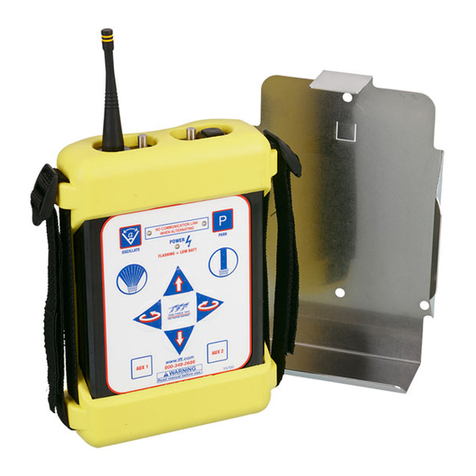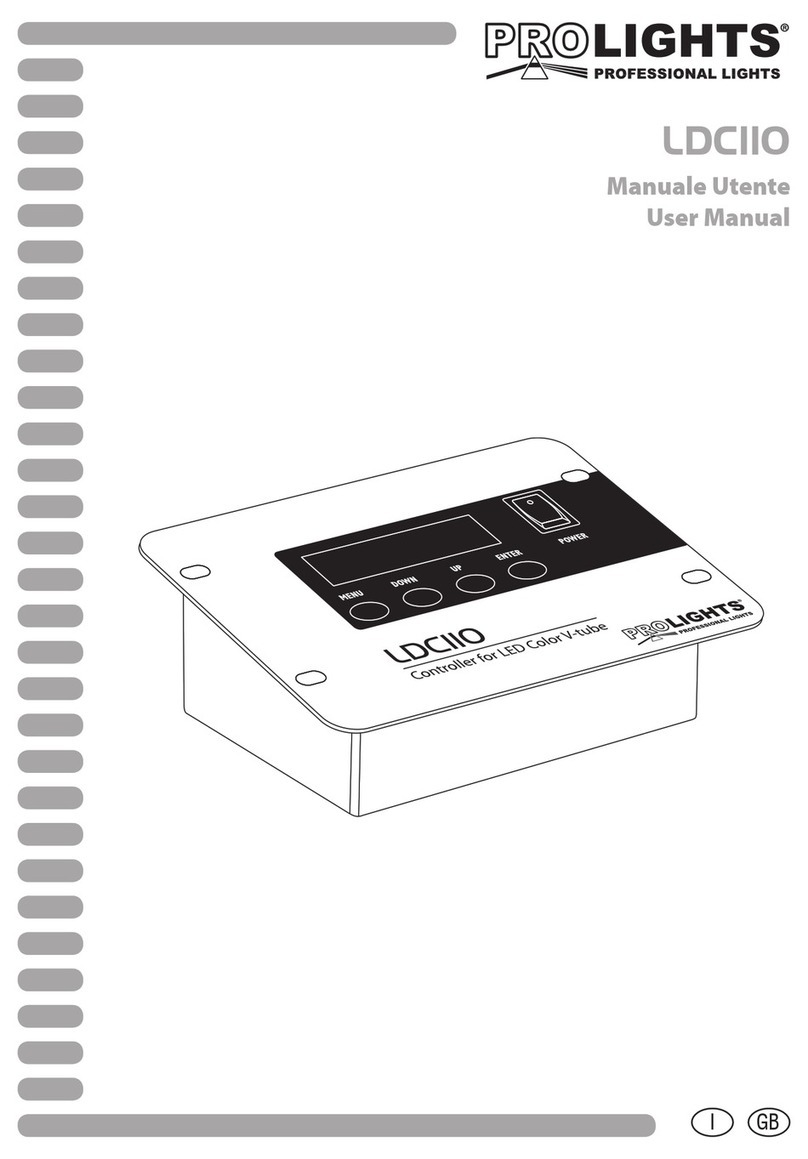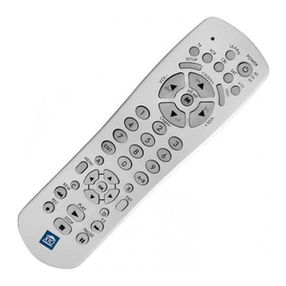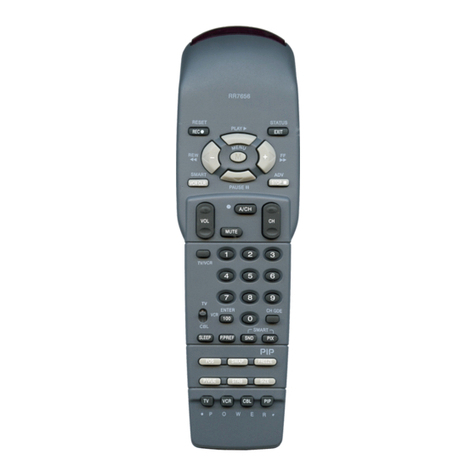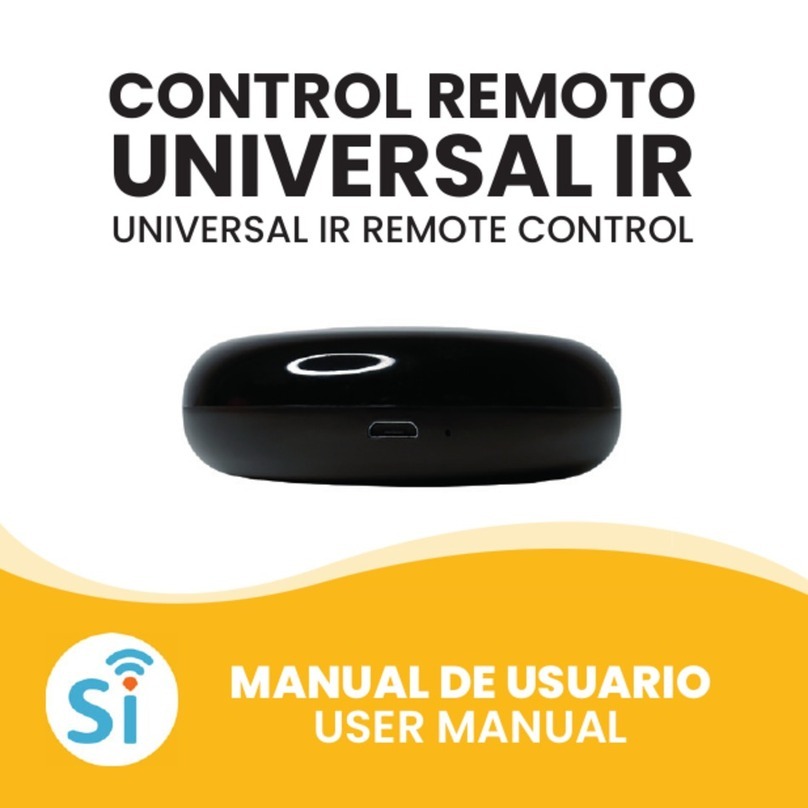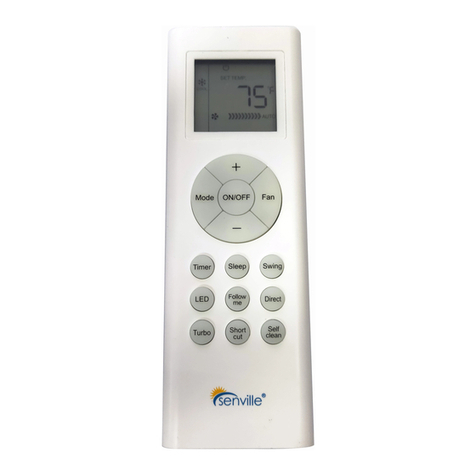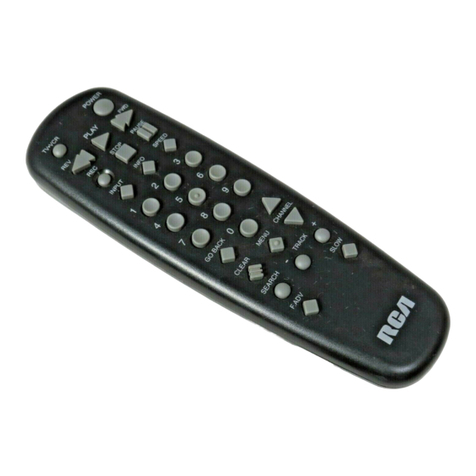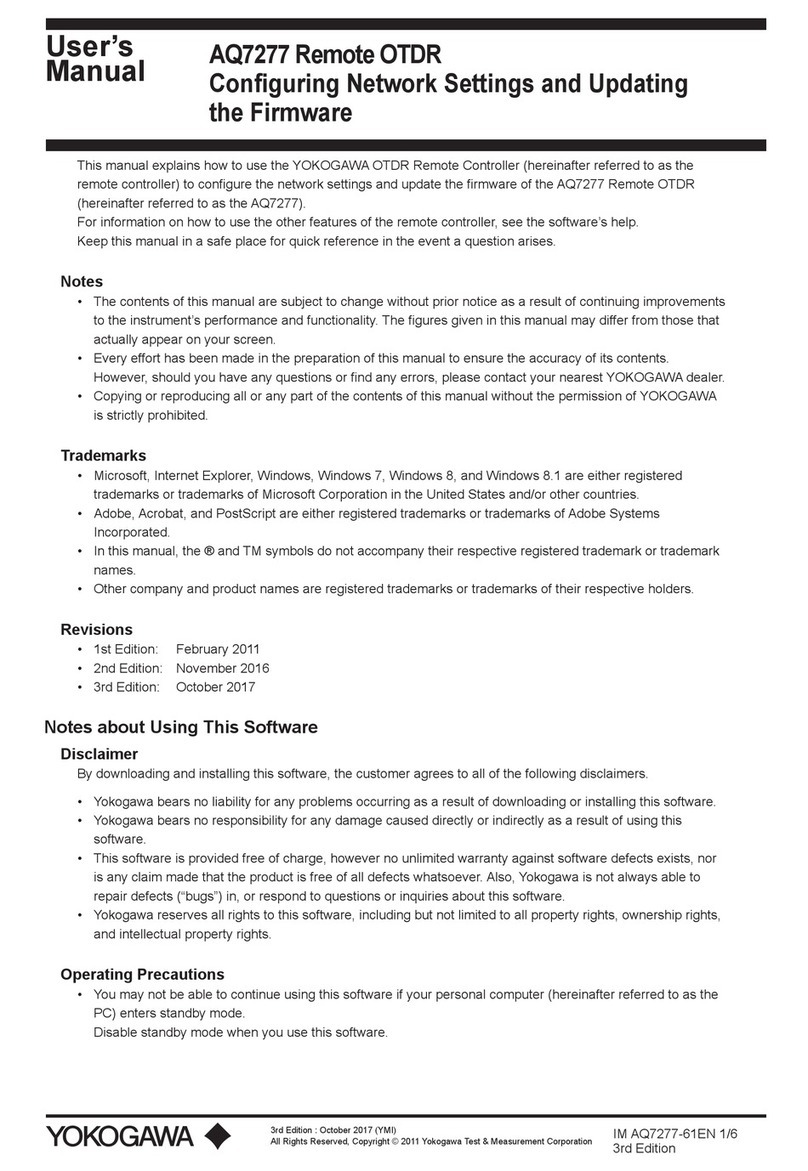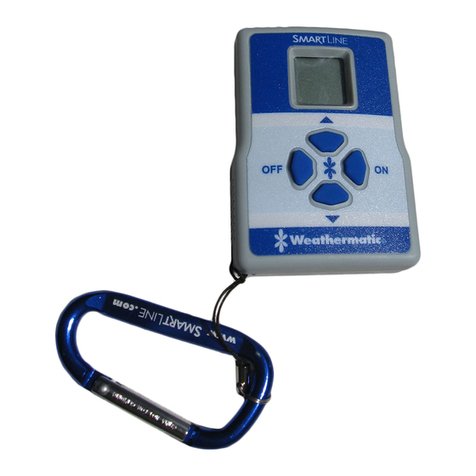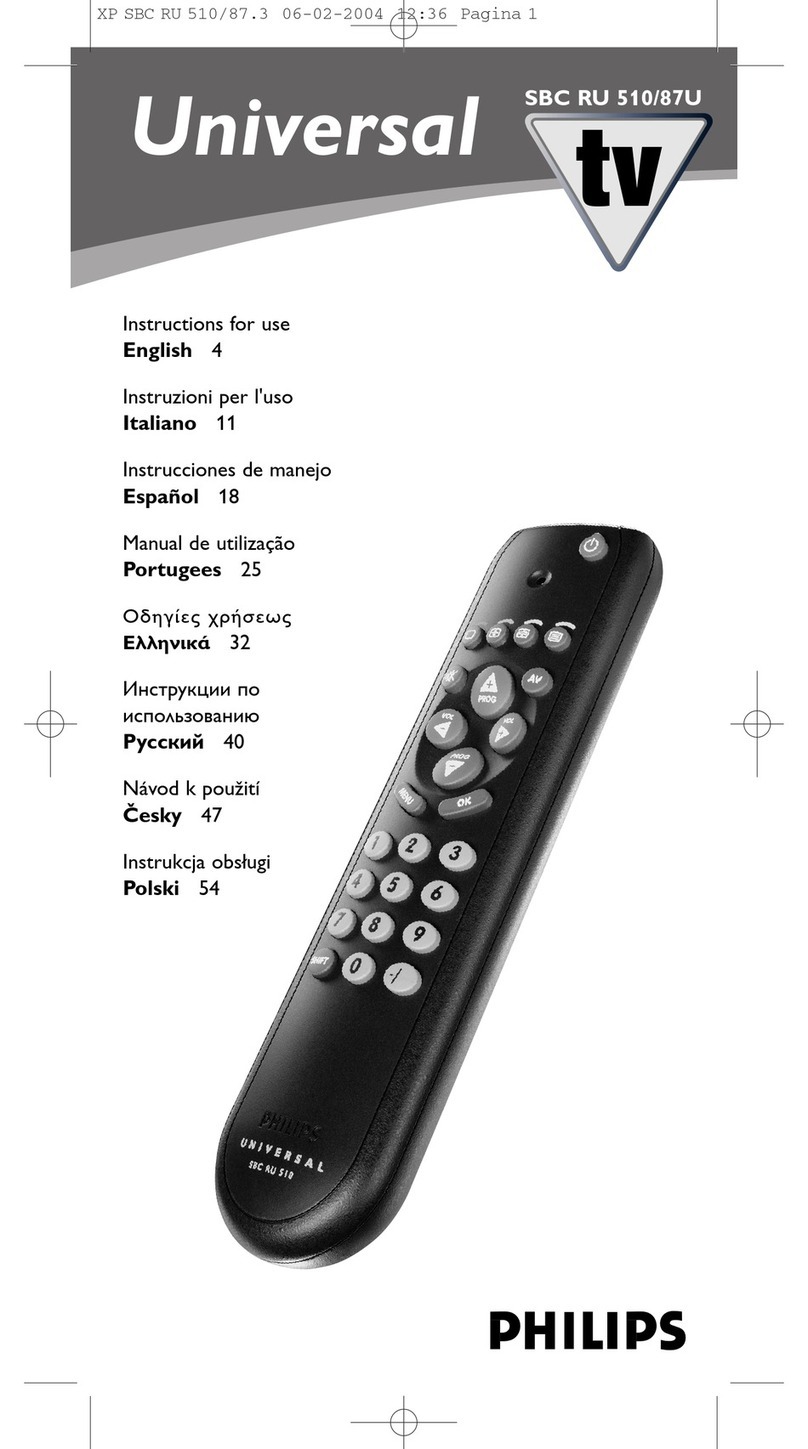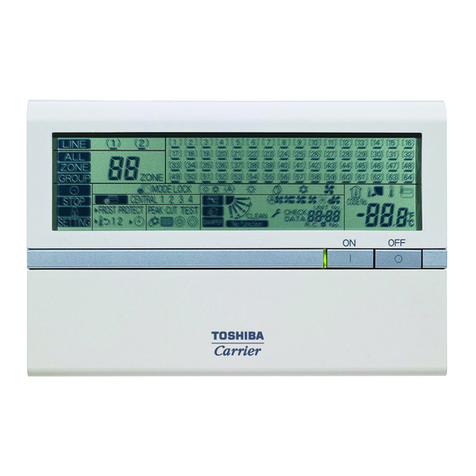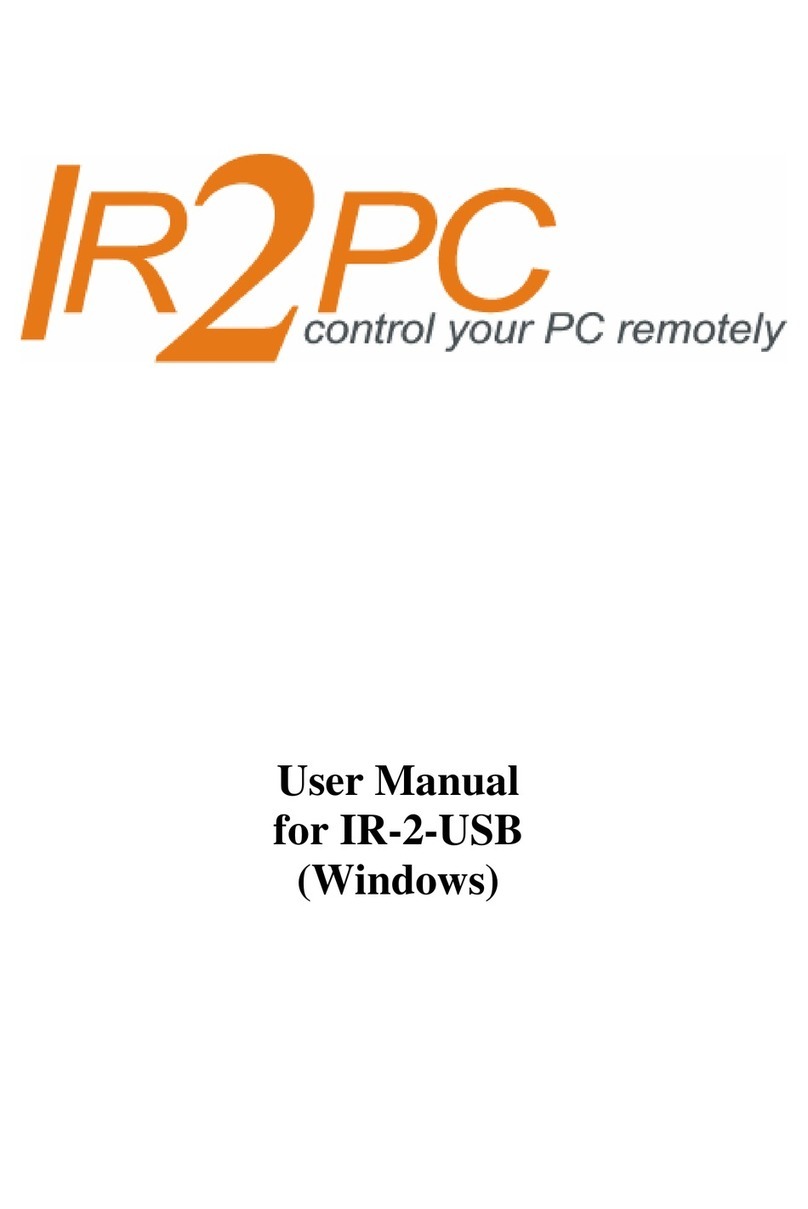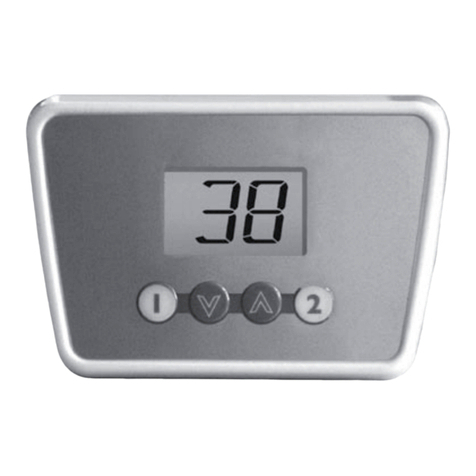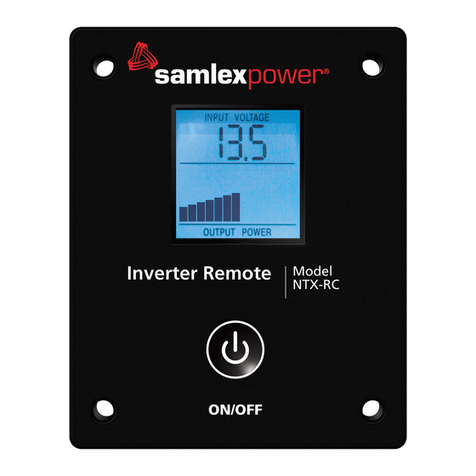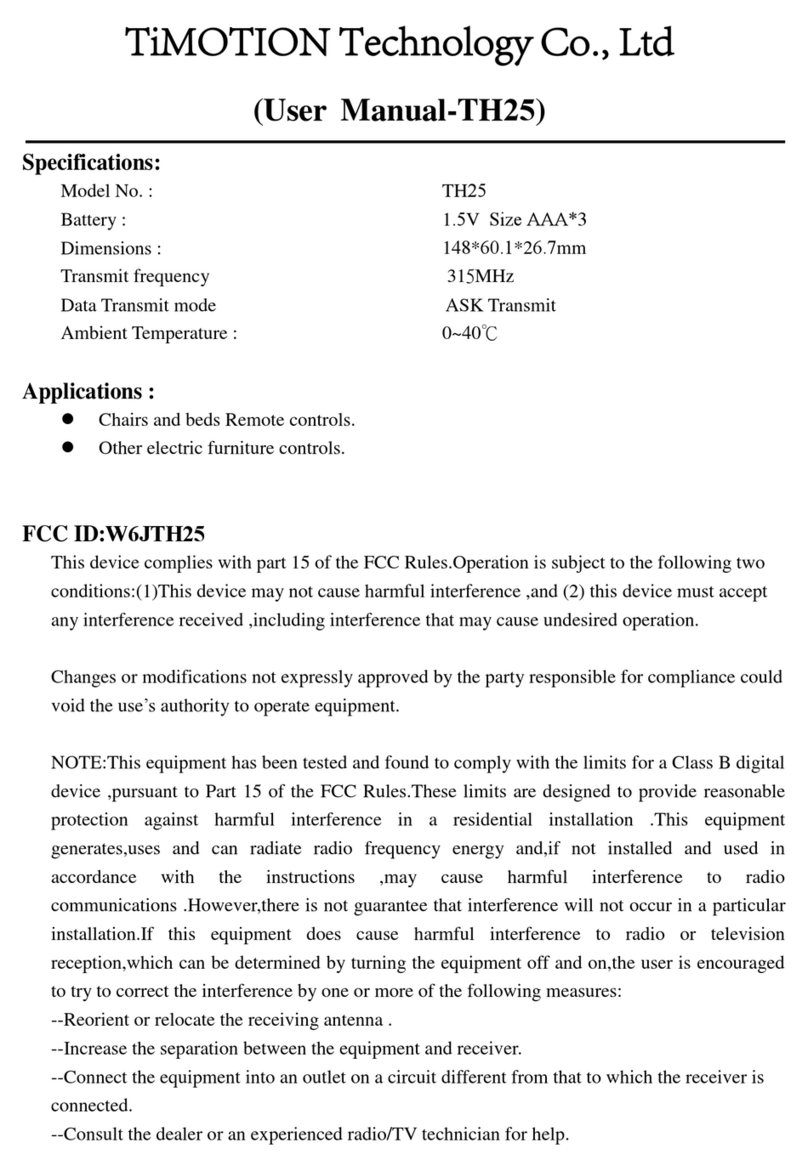Task Force Tips XFIH-E11A Programming manual

TASK FORCE TIPS, Inc. 2800 E. Evans Ave., Valparaiso, IN 46383-6940 USA
800-348-2686 • 219-462-6161 • Fax 219-464-7155
INSTRUCTIONS FOR INSTALLATION, SAFE OPERATION AND MAINTENANCE
MANUAL: Remote Control
HURRICANE RC MONITOR
Read instruction manual before use. Operation of this device without understanding the manual
and receiving proper training is a misuse of this equipment. A person who has not read and
understood all operating and safety instructions is not qualified to operate the Hurricane RC
monitor.
DANGER
This instruction manual is intended to familiarize installers,
firefighters and maintenance personnel with the installation,
operation, servicing, and safety procedures associated with
the Hurricane RC Monitor.
This manual should be kept available to all operating and
maintenance personnel.
Model XFIH-E11A Monitor
Shown With
Model M-ERP-NJ Nozzle
Maximum recommended inlet
pressure is 200 psi. (14 bar)
MADE IN USA • www.tft.com
©Copyright Task Force Tips, Inc. 2004-2006 LIX-300 January 24, 2006 Rev05
®
The member companies of FEMSA that provide emergency response equipment
and services want responders to know and understand the following:
1. Firefighting and Emergency Response are inherently dangerous activities
requiring proper training in their hazards and the use of extreme caution at all
times.
2. It is your responsibility to read and understand any user’s instructions provided
with any piece of equipment you may be called upon to use.
3. It is your responsibility to know that you have been properly trained in
Firefighting and /or Emergency Response and in the use, precautions, and
care of any equipment you may be called upon to use.
4. It is your responsibility to be in proper physical condition and to maintain the
personal skill level required to operate any equipment you may be called upon
to use.
5. It is your responsibility to know that your equipment is in operable condition and
has been maintained in accordance with the manufacturer’s instructions.
6. Failure to follow these guidelines may result in death, burns or other severe
injury.
DANGER
PERSONAL RESPONSIBILITY CODE
Fire and Emergency Manufacturers and Services Association, Inc.
P.O. Box 147, Lynnfield, MA 01940 • www.FEMSA.org
FEMSA

3.1 SPECIFICATIONS ......................................3-4
3.1.1 MECHANICAL SPECIFICATIONS
3.1.2 ELECTRICAL SPECIFICATIONS
3.2 PART IDENTIFICATION AND MODELS .......................4
3.3 INLETS AND OUTLETS..................................5-6
3.3.1 INLET FLANGE SIZE SPECIFICATIONS
3.4 OVERALL DIMENSIONS ..................................6
3.4.1 OVERALL HEIGHT INCREASE FOR INLET FITTINGS
3.5 ELECTRICAL CONTROLS .................................7
3.5.1 MOTOR CONTROL BOARD (MCB) AUTO CONFIGURE
3.5.2 MOTOR CURRENT LIMITING
3.5.3 MOTOR SOFT STOPS
3.5.4 MOTOR SLOW/FAST SPEED
3.5.5 COMMUNICATION PROTOCOL
3.5.6 OSCILLATE AND STOW FEATURES
4.1 STRUCTURAL REQUIREMENTS FOR MONITOR MOUNTING ....7
4.2 INLET FITTINGS or EXTEND-A-GUN RC INSTALLATION ......8-9
4.3 NOZZLE CONNECTION ..................................10
4.4 HORIZONTAL ROTATION TRAVEL STOPS ................10-11
4.5 PRESSURE GAGE PORT.................................11
4.6 AUTOMATIC DRAIN .....................................11
5.1 PRIMARY MONITOR OPERATOR STATION ...............13-14
5.1.1 MOUNTING
5.1.2 ELECTRICAL WIRING
5.2 OPTIONAL MONITOR OPERATOR STATIONS ................15
5.2.1 MOUNTING
5.2.2 ELECTRICAL WIRING
5.3 TETHER MONITOR OPERATOR STATION ................15-16
5.3.1 HOLSTER MOUNTING
5.3.2 RECEPTACLE MOUNTING
5.3.3 ELECTRICAL WIRING
5.4 WIRELESS MONITOR OPERATOR STATION .................16
5.4.1 MOUNTING RECEIVER
5.4.2 ELECTRICAL WIRING RECEIVER
5.4.3 MOUNTING CHARGING CRADLE
5.4.4 ELECTRICAL WIRING CHARGING CRADLE
5.5 JOYSTICK MONITOR OPERATOR STATION...............17-18
5.5.1 MOUNTING
5.5.2 ELECTRICAL WIRING
5.5.2.1 WIRING TO A COMMUNICATION INTERFACE BOX
5.5.2.2 WIRING TO PRIMARY OPERATOR STATION
5.6 TOGGLE SWITCH MONITOR OPERATOR STATION ...........18
5.6.1 ENCLOSURE MOUNTING
5.6.2 ELECTRICAL WIRING
5.7 COMMUNICATION INTERFACE BOX .......................19
5.7.1 ENCLOSURE MOUNTING
5.7.2 ELECTRICAL WIRING
5.7.3 INPUT SIGNAL CONFIGURATION
5.8 MONITOR POSITION DISPLAY ............................19
5.9 CONNECTING MONITOR CABLE DIRECTLY TO PROTECTED
POWER SUPPLY .......................................19
5.9.1 ELECTRICAL WIRING
5.10 OPERATOR STATION INSTALLATION DIRECTLY TO MONITOR ...20
5.11 HURRICANE RC AERIAL TRUCK INSTALLATION ............20-21
5.11.1 ELECTRONICS ENCLOSURE MOUNTING
5.11.2 ELECTRICAL WIRING
5.11.2.1 LADDER INSTALLATION ELECTRICAL WIRING
5.11.2.2 PLATFORM INSTALLATION ELECTRICAL WIRING
5.12
6.1 MANUAL OVERRIDE HANDWHEELS .........................22
6.2 ELECTRICAL MODEL ...................................22-24
6.2.1 OPERATOR STATIONS
6.2.1.1 MONITOR MOUNTED OPERATOR STATION
6.2.1.2 PRIMARY OPERATOR STATION
6.2.1.3 OPTIONAL OPERATOR STATION
6.2.1.4 TETHER OPERATOR STATION
6.2.1.5 WIRELESS OPERATOR STATION
6.2.1.6 JOYSTICK OPERATOR STATION
6.2.1.7 TOGGLE SWITCH OPERATOR STATION
6.2.2 MASTER OVERRIDE FEATURE
6.2.3 STOW FEATURE
6.2.3.1 PROGRAMMING
6.2.3.2 STOW PROGRAMMING EXAMPLE
6.2.4 OSCILLATE FEATURE
6.2.4.1 PROGRAMMING
6.2.4.2 OSCILLATE PROGRAM RETAIN FEATURE
6.2.5 OPERATOR STATION PANELS
6.3 RECOMMENDED MONITOR STOWING POSITION ..............25
6.5 FLOWS & PRESSURES .................................25-29
6.5.1 STACKED TIPS FLOW AND REACH
6.5.2 AUTOMATIC NOZZLES
6.5.3 HURRICANE RC MONITOR FRICTION LOSS
6.6 STREAM STRAIGHTENERS ................................29
6.6.1 STREAM STRAIGHTENERS WITH STACKED TIP NOZZLES
6.6.2 STREAM STRAIGHTENERS WITH FOG NOZZLES
8.1 LUBRICATION............................................31
8.1.1 ELEVATION CONTROL WORM GEAR
8.1.2 HORIZONTAL ROTATION WORM GEAR
8.2 PERFORMANCE TESTING .................................31
9.1 HURRICANE RC MONITOR ASSEMBLY ....................32-33
9.2 ELEVATION CHAIN DRIVE ASSEMBLY........................34
9.3 GEAR MOTOR ASSEMBLY .................................34
9.4 MONITOR CONTROL BOX ASSEMBLY........................35
1.0 MEANING OF SAFETY SIGNAL WORDS ........................3
2.0 SAFETY ...................................................3
3.0 GENERAL INFORMATION ....................................3
4.0 INSTALLATION 7-8
5.0 ELECTRICAL CONTROLS INSTALLATION......................12
6.0 OPERATION ................................................21
7.0 TROUBLESHOOTING.........................................30
8.0 MAINTENANCE AND INSPECTION ..............................31
9.0 EXPLODED VIEW DRAWINGS AND PARTS LIST ................32-35
10.0 WARRANTY.........................................Back Cover
ELECTRICAL NOZZLE ACTUATOR WIRING ...................21
6.4 AUTOMATIC DRAIN .......................................25
Table of Contents
2

CAUTION The electric Hurricane RC may be remotely operated. The electric drives are current limited but
may still produce enough force to cause injury. Keep hands and fingers away from pinch points on
the monitor.
CAUTION
CAUTION
CAUTION
Do not use the manual override handwheels while the electric controls are in operation. The
electric drives produce enough torque to cause injury.
Maximum pressure is 200 psi (14 bar). Damage or injury may result if the monitor is operated
beyond these limits.
1.0 MEANING OF SAFETY SIGNAL WORDS
A safety related message is identified by a safety alert symbol and a signal word to indicate the level of risk involved with a
particular hazard. Per ANSI standard Z535.4-1998, the definitions of the three signal words are as follows:
DANGER
CAUTION
WARNING
DANGER indicates an imminently hazardous situation which, if not avoided, will result in death or
serious injury.
WARNING indicates a potentially hazardous situation which, if not avoided, could result in death
or serious injury.
CAUTION indicates a potentially hazardous situation which, if not avoided, may result in minor or
moderate injury.
The stream exiting a monitor is very powerful and capable of causing injury and property damage.
Make sure the monitor is securely attached to the base and pointing in a safe direction before water
to the monitor is turned on. Use care in directing the stream.
Injury can result from an inadequately supported monitor. The monitor mount must be capable of
supporting 1500 lbs (700 kg) of nozzle reaction force.
2.0 SAFETY
3.0 GENERAL INFORMATION
WARNING
The operation of this monitor can be dangerous. The following must be observed at all times.
The Task Force Tips’ HURRICANE RC is an electric remote monitor, with a single low-profile waterway discharge. It has high flow and
low friction loss characteristics. Capable of flowing 1250 gpm (4500 l/min) while maintaining a FULL450° of rotational travel (225° either
side of center position). Maximum operating pressure is 200 psi (14 bar). Field changeable horizontal rotation stops at 45°, 90° and 135°
either side of center position. Elevation range is 90° above horizontal and 45° below. Designed for field changeable 12 or 24 VDC
operation. The Hurricane RC comes with a factory installed control panel mounted on the monitor for controlling horizontal rotation,
elevation and nozzle pattern. See Task Force Tips’ Price List and Product Specifications for additional control stations. Unit comes with
30 feet of ultra-flexing robotic cable, enclosed in a unique wire guide, already wired to the monitor so installation effort is minimized.
Large handwheels are provided on the horizontal rotation and elevation drive for manual override. TFT's Master Stream 1250 nozzle
plugs into the factory installed nozzle power wire. All electrical components affecting water tightness are a minimum of NEMA 4 (IP65).
Motors and control boxes are factory tested for water tightness. Available with various inlet adapters for flanges and thread fittings. Inlet
also made for direct connection to TFT's Extend-A-Gun RC3 or RC4. Standard outlet is 2-½” National Hose male (65mm). Other outlets
are available (see figure 3.3). A threaded port (0.25” NPT) (6.4mm) is provided for pressure gauge. The monitor is made from hardcoat
anodizedANSI 356.0-T6 aluminum and silver powder coat finish inside and out.
3
3.1 SPECIFICATIONS
Weight 39 lbs 17.7 kg
Min. Flow Area 7.07 in 45.6 cm - 3” inlets
Max Flow 1250 gpm 4500 l/min
Max Operating Pressure 200 psi 14 bar
Materials Used ANSI 356.0-T6 Aluminum, Stainless, Nylon
22
3.1.1 MECHANICAL SPECIFICATIONS
On many vehicle installations the monitor is the highest point on the apparatus. Often it is critical that the monitor be properly stowed
before driving to avoid damage to overhead obstructions such as door openings. In these cases the use of a switch wired into the
apparatus "door open" circuit is highly recommended. The switch should be wired to give a "door open" signal if the monitor is not in the
stowed position. Due to the variety of possible mountings and nozzles, it is the installer's responsibility to supply the appropriate switch
with mounting and wire it into the system.Always check stowed position of the monitor before moving the apparatus.

BUILT IN
STREAM
STRAIGHTENER
ELEVATION DRIVE
HOUSING
(SECT. 9.2)
HORIZONTAL
ROTATION TRAVEL
STOPS 5 PLACES
(SECT. 4.4)
AUTOMATIC
DRAIN
(SECT. 4.6 & 6.4)
OUTLET
(FIGURE 3.3)
GREASE ZERK
(SECT. 8.1)
PRODUCT NAME LABEL
WITH
SERIAL# & MODEL #
POWER CABLE
ELEVATION
MOTOR (SECT. 9.3)
WIRE SKIRT/CABLE GUIDE
(SECT. 9.1)
INLET
(FIGURE 3.3)
STRAIGHT BACK
REFERENCE MARK
(SECT. 4.2)
PORT FOR
PRESSURE GAGE
(SECT. 4.5)
HORIZONTAL
ROTATION
HANDWHEEL
(SECT. 6.1)
ELEVATION
HANDWHEEL
(SECT. 6.1)
CONTROL STATION BOX
WITH CONTROL BUTTONS
(SEE SECT. 6.2.1.1)
GREASE ZERK
(SECT. 8.1)
HORIZONTAL
MOTOR (SECT. 9.3)
Nominal Operating voltage: 12 or 24 VDC
(field changable)
Motor current: Nominal* Limit
Elevation motor: 6 amps 15 amps
Horizontal rotation motor: 6 amps 10 amps
Nozzle motor: 1 amp 5 amps
*with rated water pressure applied
At rest current: .25 amps
Recommended fuse or circuit breaker size: 15 amps @ 12 volts, 7.5 amps @ 24 volts
Operating temperature range: -30°F to +120°F (-34°C to +49°C)
Environmental Rating: All components designed to meet minimum rating of NEMA 4 (IP65).
3.2 PART IDENTIFICATION AND MODELS
The Hurricane RC Monitor as shown in Figure 3.2 along with the names of some various parts and controls.
FIG 3.2
Part Identification
4
3.1.2 ELECTRICAL SPECIFICATIONS
Charging Cradle
Nominal Operating Voltage 12 or 24 VDC
Operating Current 0.15 amps
Recommended Fuse or Circuit Breaker 2 amps
Transmitter Batteries Uses four (4) AA NiCad Batteries
Transmitter Power 5mW
Operating Frequency 2.4 GHz
Agency Approvals FCC Part 15 - United States
ISC - Canada
CE - European Union
Wireless Operator Station

3.3 INLETS AND OUTLETS
The standard Hurricane RC Monitor inlet is CODE-RLF for direct connection to TFT's Extend-A-Gun RC3. Monitor inlet CODE-RPF is
available for direct connection to Extend-A-Gun RC4. The standard outlet is 2-½”-6 National Hose male. Various other inlet and oputlet
fittings are available as shown in Figure 3.3.
5
FIG 3.3
Inlets And Outlets
2.5"-7.5 NH
(65mm) MALE
2.5"-11 BSP
(65mm) MALE
2.5"-11.5 NPSH
(65mm) MALE
SPECIAL
THREADS
CODE-RLF FEMALE
or
CODE-RPF FEMALE
3.0" NPT FEMALE (Y4440NL)
or
4.0" NPT FEMALE (Y4450NP)
EXTEND-A-GUN RC3
or
EXTEND-A-GUN RC4
3.0"ANSI 150 (Y4410A)
or
4.0"ANSI 150 (Y4415A)
or
DN80, PN16 (Y4423A)
or
DN100, PN16 (Y4425A)
FLANGE
3.0"BSP MALE (Y4420A)
or
4.0"BSP MALE (Y4430A)

3.4 OVERALL DIMENSIONS
6
FIG 3.4
Overall Dimensions
3.4.1 OVERALL HEIGHT INCREASE FOR INLET FITTINGS
MODEL INLET FITTING TYPE ADDITIONAL HEIGHT OVERALL HEIGHT
XFIH-E1*A
XFIH-E2*A
XFIH-E4*A
XFIH-E5*A
XFIH-E6*A
XFIH-E7*A
XFIH-E8*A
XFIH-E9*A
3” ANSI 125/150 .75” 16.18”
(metric DN8 PN20) 20 mm 412 mm
4” ANSI 150 .94” 16.37”
(metric DN100 PN20) 23 mm 415 mm
metric DN80, PN16 2.80” 18.23”
22 mm 414 mm
metric DN100, PN16 2.80” 18.23”
22 mm 414 mm
3” NPT Female 2.00” 14.43”
51 mm 443 mm
4” NPT Female 1.75” 17.18”
45 mm 436 mm
3” BSP Male 2.30” 17.73”
58 mm 450 mm
4” BSP Male 2.30” 17.73”
58 mm 450 mm
* The second to last digit in the model number refers to exit thread size and type.
18.64
[473MM]
15.43
[392MM]
7.90
[201MM]
10.74
[273MM] 5.89
[150MM]
3.64
[93MM]
SHOWN
WITHOUT
INLET FITTING
(SEE TABLE
IN SECT. 3.4.1
FOR
ADDITIONAL
HEIGHTS)
V
E
R
T
I
C
A
L
R
A
N
G
E
O
F
M
O
T
I
O
N
A
B
O
V
E
4
5
D
E
G
.
B
E
L
O
W
9
0
D
E
G
.
3.3.1 INLET FLANGE SIZE SPECIFICATIONS
MODEL FITS FLANGE OUTSIDE THICKNESS BOLT HOLE
HOLES BOLTS
XFIH-E1*A 3” ANSI 125/150 7.5” .75" 6.0" 4 5/8" 76-80 FT-LBF
(metric DN8 PN20) 190mm 20mm 152.5mm 4 M16 100-110 Newton Meters
XFIH-E2*A 4" ANSI 150 9.0" .94" 7.5" 8 5/8"
NO. BOLT SIZE OF TORQUE ON BOLTS
DIAMETER CIRCLE
76-80 FT-LBF
(metric DN100 PN20) 230mm 23mm 190.2mm 8 M16 100-110 Newton Meters
XFIH-E4*A metric DN80, PN16 200 mm 22 mm 160 mm 8 16 mm 100-110 Newton Meters
XFIH-E5*A metric DN100, PN16 220mm 22 mm 180 mm 8 16 mm 100-110 Newton Meters
* The second to last digit in the model number refers to exit thread size and type.

7
3.5 ELECTRICAL CONTROLS
The electric Hurricane RC monitor is controlled by a very powerful, state-of-the-art electronics system. The key components of the
system are the motor control boards and a communication board. Each motor control board has its own microprocessor and a
sophisticated motor control chip. The communication board also has a microprocessor, which handles the interface to the operator
stations. All the components on these boards are solid state; there are no relays or electro-mechanical devices to wear out over time.
The hardware and software have been designed with several key features:
3.5.1 MOTOR CONTROL BOARD (MCB) AUTO CONFIGURE
Each monitor has three MCBs, one for each motor, which controls motor movement and direction for horizontal rotation, elevation, and
nozzle pattern. In the unlikely event of a MCB failure, the failed board can be removed and one of the other two remaining MCBs can be
moved into that position. This MCB will then auto configure itself to take over the control of that axis, so that the monitor can continue to
be used, with two of the three motors. This is also a helpful benefit when troubleshooting and requires fewer spare parts to be stocked.
3.5.2 MOTOR CURRENT LIMITING
The microprocessor on the MCB continuously monitors the motor current. As the motor reaches an end stop or if there is an obstruction,
the motor current rises very quickly and the motor control chip automatically shuts down the motor in a few milliseconds. This eliminates
the need for any type of external limit switches and the associated wiring. The microprocessor also locks the operator from moving in the
stopped direction again, until the operator first moves in the opposite direction.
3.5.3 MOTOR SOFT STOPS
The horizontal and vertical motors are equipped with feedback encoders, which allow the microprocessor to know the motor position at
all times. The first time a motor reaches an end stop or strikes an obstruction, the microprocessor sets a new soft stop position just
before the end stop. From that point on, when the axis approaches the stop, the MCB automatically slows down the motor until the end
stop is reached. This significantly reduces the wear on the motor, gearbox, and external gears.
3.5.4 MOTOR SLOW/FAST SPEED
When an operator presses one of the buttons, the associated motor starts in slow speed mode so that the operator can accurately
control the water stream. After approximately 1-2 seconds the motor automatically ramps up to a fast speed, for quickly moving into
position. When quickly changing directions, monitor retains speed from prior move. If low speed is selected, monitor does not ramp to
high speed but remains in slow speed.
3.5.5 COMMUNICATION PROTOCOL
The communication from the monitor to the operator stations is performed over two wires using RS-485 serial protocol. Multiple
operator stations can be added with only two wires for power and two wires for the RS-485 protocol between each station.
4.1 STRUCTURAL REQUIREMENTS
FOR MONITOR MOUNTING
The structure that the Hurricane RC Monitor is mounted to must
withstand the internal pressure of the monitor as well as shear and
bending forces due to nozzle reaction. Nozzle reaction can be as
high as 1,050 lbs (480 kg) (1250 gpm at 200 psi).
For flanged connections, the use of flat flanges without raised faces
is recommended. Use a full-face gasket as defined in SME 16.21 or
ISO 7483. Tighten flange bolts in an alternating sequence as shown
in figure 4.1. Tighten to 76-80 ft-lb (100-110 Newton-Meters).
4.0 INSTALLATION
Injury can result from an inadequately supported monitor. The monitor mount must be capable of
supporting the nozzle reaction force which can be as high as 1500 lbs (700 kg). Flanges and pipe
made from plastic are inadequate for monitor mounting and must not be used. This monitor is not
recommended for portable use.
WARNING
FIG 4.1 - Flange Bolt Tightening Sequence
Tighten sequentially each bolt three times.
1
2
3 4
1
2
3
5
6
7
8
4
3.5.6 OSCILLATE AND STOW FEATURES
The OSCILLATE feature allows the user to program up to 65 points of continuous movement of the horizontal and vertical axes. The
OSCILLATE pattern can be programmed from any operator station that has the OSC button.
The STOW feature allows the user to move the monitor, with one touch of a button, to a safe position before moving the fire truck. The
monitor will always move to two end stops to verify the correct position. During the programming procedure, the user has the ability to
select which axis moves first. This is helpful to avoid lights, hoses, obstructions, etc. The user can program up to 10 points of movement
to reach the final STOW position. The STOW pattern can be programmed from any operator station that has the STOW button.
See section 6.2.3 and 6.2.4 for programming instructions.

8
4.2 INLET FITTINGS OR EXTEND-A-GUN RC INSTALLATION
The Hurricane RC Monitor is available with various inlet fittings as shown in figure 3.3. The Hurricane RC Monitor also connects directly
to TFT's Extend-A-Gun RC3 or RC4. The fittings and Extend-A-Gun RC are attached to the monitor by means of a threaded joint with an
o-ring seal. Once in the proper orientation, the threaded joint is locked from rotation by two ¼-28 button head cap screws as shown in
figure 4.2A. This makes for easy removal of the monitor, since the large threads of the joint are not tightened and do not have any thread
locking compounds on them. It is best to install the inlet fitting or Extend-A-Gun RC to the apparatus and than install the monitor to the
inlet fitting or Extend-A-Gun RC. This gives more room to install the bolts in the case of flanged fittings. Referring to figures 4.2A and
4.2B, the installation sequence is as follows:
1) Install inlet adapter or Extend-A-Gun RC to apparatus.
• Mount so that 180 degree apart threaded cross holes will give desired direction relative to the “Straight Back Reference Mark”
when the monitor is installed.
2) Screw monitor onto inlet adapter or Extend-A-Gun RC until threaded joint bottoms out.
• Do not use pipe dope or Loctite on the inlet base threads. These threads are sealed with an o-ring. The use of thread locking
compounds will make removal difficult.
3) Unscrew monitor slightly until a pair of 90 degrees apart slots line up with the 180 degrees apart threaded cross holes in the inlet
adapter or Extend-A-Gun RC.
• Orient monitor so that the Straight Back Reference Mark is facing the desired direction.
• Slots will line up with threaded cross holes every 90 degrees of rotation.
• Monitor may be unscrewed up to one full turn from the bottomed out position.
4) Install ¼-28 by ½ long button head cap screws and washers in the two threaded cross holes.
FIG 4.2A
3” Inlet Fitting Connection
(This view shown without power cable guide for purposes of illustration.)
90 DEGREE
APART SLOTS
180 DEGREE APART
THREADED HOLES
INLET BASE
INLET FITTING MOUNTED TO APARATUS
3.0" ANSI 150 SHOWN, OTHERS SIMILAR
1/4-28 X 1/2LONG
BUTTON HEAD
CAP SCREW
2 PLACES
(TFT# VT25Y28BH504)
WASHER 2 PLACES
(TFT# VW687X281-50)
STRAIGHT BACK
REFERENCE MARK

9
FIG 4.2B
Possible Extend-A-Gun RC Mounting Orientations
The Extend-A-Gun RC manual override knob may be mounted
in any one of four possible orientations (90 degrees apart).
STRAIGHT BACK
REFERENCE MARK
(SEE FIGURE 4.2A)
MANUAL OVERRIDE
KNOB ON
EXTEND-A-GUN
1-1/4 TURNS
APPROX. 34 IN.
1 TURN
APPROX. 33 IN.
3/4 TURNS
APPROX. 33 IN.
1-1/2 TURNS
APPROX. 37 IN.
The Extend-A-Gun manual override knob may be mounted in any of four possible orientations (90 degrees apart) relative to the Straight
Ahead Reference Mark on the monitor.
NOTE: Hurricane RC monitor, for use with Extend-A-Gun RC, comes with the wire installed in a nylon tube. The nylon tubing gives the
wire additional stiffness so it better follows as the Extend-A-Gun RC extends or retracts. A fitting is also supplied and is to be used where
the nylon tubing and wire pass though the deck.

4.3 NOZZLE CONNECTION
The Hurricane RC monitor outlet thread types are as shown in figure 3.3. The nozzle is simply screwed onto the Hurricane RC monitor's
exit threads. Insure that the nozzle's coupling does not make contact with the elevation drive housing when the monitor is in its highest
elevation position.
For nozzles with electric pattern control, a waterproof connector wire is provided at the bottom outlet of the Hurricane RC's control
station box. This wire attaches directly to TFT's electric Masterstream 1250 nozzle. The electric actuator box of nozzle must be oriented
to the top side of nozzle for the connection wire to extend 90° above horizontal and 45° below elevation movement. (see figure 4.3 and
refer to Sections 5.12 and 6.6.2 for properly attaching female to male connectors). Any other nozzle should have the corresponding
male electrical connector installed and long enough wire to extend of the
nozzle.
90° above horizontal and 45° below elevation movement
DO NOT CUT OFF THE FEMALE CONNECTOR ON THE MONITOR. THIS CONNECTOR IS MOLDED ONTO THE WIRE
AND MUST REMAIN ON TO MAINTAIN THE WATER TIGHTNESS OF THE ELECTRICAL SYSTEM.
CAUTION The nozzle threads must match the threads on the Hurricane RC in both size and type.
Mismatched or damaged threads may cause the nozzle to leak or uncouple under pressure and
could cause injury.
CAUTION Do not connect aluminum to brass or brass to aluminum. Dissimilar metals coupled together can
cause galvanic corrosion that will freeze the threaded joint or cause complete loss of thread
engagement. If dissimilar metals must be coupled together, the effects of corrosion can be greatly
delayed by various coatings on the metal such as powder paint, hard anodizing or silicone grease.
FIG 4.3
Correct ER Nozzle Install Orientation
CAUTION:
TFT's Master Stream 1250 ER Nozzle
Electric Actuator Box must be on the Top
Side for its Edge to line up with Monitor
Waterway Top Body as shown.
4.4 HORIZONTAL ROTATION TRAVEL STOPS
The range of Horizontal (left-right) travel for the Hurricane RC monitor is limited to 450 degrees or 225 degrees from either side of a
nozzle discharge position. Horizontal (left-right) travel stop bolts may be installed in the monitor to limit travel as shown in figure 4.4A and
4.4B. Note that left and right are relative to the “Straight Back Reference Mark” shown in figure 4.4A, and refer to the operator's position
behind the monitor, opposite the nozzle's discharge direction. Also, Figure 4.4A shows the range of travel for the various stop bolt
locations along with installation notes as shown in Figure 4.4B.
10

11
FIG 4.4A
Horizontal Travel Limits
FIG 4.4B
Horizontal Travel Stop Bolt Locations
4.5 PRESSURE GAUGE PORT
There is a ¼” NPT female threaded hole located behind the elevation hand wheel for the installation of a pressure gauge if desired. This
hole has a pipe plug installed from the factory. Unscrew the pipe plug and install the gauge using pipe sealant. Make sure that the gauge
does not interfere with the handwheel.
4.6 AUTOMATIC DRAIN
There is an automatic drain on the Hurricane RC installed from factory, that will empty the water from the low point of the lower bend to
prevent freezing (Figure 3.2). This valve will close automatically when the internal pressure in the monitor reaches approximately 5 psi
(0.34 bar) and will reopen again when the pressure drops to this point. Refer to Section 6.4 for disabling the automatic drain if desired.
Asecondary drain valve should be installed on the monitor's inlet piping to drain water in the riser.
45°RIGHT
90°RIGHT
Pry out plastic plug and
install Stop Bolt(s)
to obtain desired
travel limits.
(TFT# Y4145)
135° LEFT AND RIGHT
(ONLY ONE STOP BOLT
NEEDED FOR THIS
TRAVEL LIMIT)
90°LEFT
45°LEFT
STRAIGHT BACK
REFERENCE MARK

12
5.0 ELECTRICAL CONTROLS INSTALLATION
The electric RC monitor is supplied with a monitor mounted operator station. The wiring on the monitor and for this operator station is
factory installed. The assembly is supplied with a 30-foot length of cable for connection to the operator control stations as shown in
Figure 5.0 or directly to a protected voltage supply. This cable has 4-conductors which supply power and the communications from the
operator stations to the monitor. To complete the installation, the installer will need to mount and wire the selected operator stations. The
power supply for the monitor will need to be connected to a protected circuit from the truck's power distribution center. Refer to the
specifications section 3.2.1 for nominal current draw.
Good mechanical connections on the wires are absolutely necessary and should be checked periodically. Poor electrical
connections can cause power loss to the electric RC monitor and be a fire hazard.
Careful selection of wiring is critical to avoid excessive voltage drop.
Be careful to route cables in a protected area away from high heat sources.
Use grommets whenever wires pass through holes to prevent damage due to snags, abrasions, etc.
Secure cables close to control box with plastic wire ties or cable clamps to relieve stress on the cables.
Disconnect power before installing or servicing the electrical components. The RC monitor control boxes and motors are not rated
as ignition proof, explosion proof, or intrinsically safe.
!
!
!
!
!
!
The electric motors and other components are ignition sources. The electric drives should be
operated only in areas where there is adequate ventilation and no hazard of flammable vapor
buildup.
WARNING
11/32” nut driver 20mm open-end box wrench
17mm open-end box wrench
5/32” drill bit
25/32” drill bit
#2 Phillips screwdriver
Small flat blade screwdriverWire cutter/stripper
Terminal crimping tool
Utility knife
Recommended Tool List
FIG 5.0
Electrical Components
(non-aerial installation)
NOTE: To avoid excessive voltage
drop at monitor operator station, do
not lengthen factory supplied power
or monitor cable.
Voltage supplied to PRIMARY
OPERATOR STATION should not fall
below 13 volts when monitor is in
operation.
Joystick Operator
Station Sec 5.5
Wireless Operator
Station Sec 5.4
Charging Cradle
Receiver
Deutsch
Connector
7/C-20 9/C-20
Primary Operator
Station Sec 5.1
10 ft (3m) Maximum Power
2/C-14 * See Note
Monitor Mounted
Operator Station
30 ft (9m) Maximum
2/C-14, 2/C-20
Optional Operator
Station Sec 5.2 Tether Operator
Station Sec 5.3
2/C-14, 2/C-20
30 or 100 ft
(9 or 27m)
Toggle Switch
Operator Station Sec 5.6
Communication
Interface Box Sec 5.7

13
5.1 PRIMARY MONITOR OPERATOR STATION
This operator station will include the wiring connections for the
cable from the monitor and the incoming power. In many
installations this operator station will also include the wiring
connections for the wireless, joystick, or tether operator station. The
enclosure is designed to be recess mounted in a panel.
5.1.1 MOUNTING
Select proper operator location. Panel space required will be 5-5/8”
x 8” (142 x 200mm). A depth of 3-1/2” (89mm) will be required
behind the panel. Additional space will be required where the
cables exit the back of the enclosure. Refer to Figure 5.1.1 for
cutout dimensions.
Fig 5.1.1
Primary & Optional Operator Stations Cutout Dimensions
5.1.2 ELECTRICAL WIRING
After selecting and mounting the desired operator stations, refer to Figures 5.1.2B-E for wiring connections. Refer to Figure 5.1.2A for
typical cable preparation. Be sure to tighten all terminal block screws securely.
FROM/TO MONITOR OR OPERATOR STATION
FROM/TO TETHER OR OPT. STATION
WIRELESS STATION
Refer to Figure 5.1.2B for connections.
Remove rubber plug in hole labeled WIRELESS OPER. STATION and discard. Refer to Figure 5.1.2C for connections.
Plug end of cable with Deutsch connector into gray receptacle on receiver. Make sure connector snaps into place.
Remove rubber plug in hole labeled WIRELESS OPER. STATION and discard.
Refer to Figure 5.1.2D for connections. Refer to Figure 5.1.2 for wire color designations.
OPERATOR
OPERATOR
MAIN POWER CONNECTION TO TRUCK
Route cable and connect to a protected circuit from the truck’s power distribution center. Connect the red wire to positive and
the black wire to negative (ground). Refer to Figure 5.1.2E for connections.
IMPORTANT!!
When mechanical installation and electrical connections are complete, perform the following test to verify voltage supply is adequate
and the current limiting feature is functioning.
1) Apply power to monitor control box.
2) Press LEFT or RIGHT button and hold until monitor reaches its stop position. Continue to hold button down.
3) Once movement is stopped, manually turn override knob in opposite direction while continuing to hold button down. If knob
can be turned, then voltage supply is adequate. If knob cannot be turned and motor continues to operate, then the voltage
supply or wiring is not adequate. Check connections and voltage connection point, rewire if necessary. NOTE: Override
knob will only turn in one direction.
Receiver Cable Termination Point In
Wire Color Operator Station
RED RED (+)
BLACK BLACK (-)
GREEN/BLACK UP
WHITE/BLACK DOWN
WHITE LEFT
ORANGE/BLACK RIGHT
BLUE FOG
ORANGE STRAIGHT STREAM
GREEN NOT USED (CUT)
Fig 5.1.2A
Typical Cable Preparation
5-1/8
(130 mm)
7-7/16
(190 mm)
NOTE: CABLE IS GEL FILLED TO
PREVENT MOISTURE WICKING
INTO ENCLOSURE. GEL IS NON-
HAZARDOUS AND SHOULD BE
WIPED OFF CONDUCTORS
WITH RAG.
Fig 5.1.2
Wireless Operator Station
Wiring Color Code

14
FIG 5.1.2C
From/To Tether, Optional Operator Station
Toggle Switch Operator Station,
or Communication Interface Box.
FIG 5.1.2B
From/To Monitor Or Operator Station Connections
VERIFY RUBBER SEAL IS CLEAN AND UNDAMAGED.
VERIFY THAT NO WIRES ARE CAUGHT BETWEEN LID AND BOX.
USE SUPPLIED FLAT HEAD
SCREWS WITH O-RING SEALS.
TIGHTEN SCREWS SECURELY.
(6) PLACES.
FIG 5.1.2D
Wireless Operator Station Connections
WIRELESS
STATION ONLY
WIRELESS OPERATOR STATION.
JOYSTICK OR INSTALLER SUPPLIED SWITCHES.
SEE SECTION 5.1.2 FOR TABLE DEPICTING
WIRELESS RECEIVER COLOR CODE.
FIG 5.1.2E
Main Power Connections
BLUE AND WHITE
NOT USED
RED AND BLACK
TO POWER DISTRIBUTION CENTER
10 FT. (3M) MAXIMUM LENGTH

5.2 OPTIONAL MONITOR OPERATOR STATIONS
The electronic package for the Hurricane RC is designed for multiple operator stations. The operator stations use an RS-485
communication design and the communication boards in each station are connected in series. This gives the flexibility to choose more
than one location on a truck to operate the monitor. To install multiple operator stations, complete the following instructions in this section
and repeat for each additional station. The enclosure is designed to be recess mounted in a panel.
5.2.1 MOUNTING
See section 5.1.1
5.2.2 ELECTRICAL WIRING
See section 5.1.2
5.3 TETHER MONITOR OPERATOR STATION
This operator station will have a factory installed 4-conductor cable, which will act as a tether, with a plug on the end. The installer will
need to mount the holster and receptacle. Since the communication boards are connected in series, the receptacle for the tether
operator station needs to be wired into the last primary or optional operator station (if multiple recessed operator stations are installed,
refer to section 5.2).
The holster is supplied with(3) 1/4-20 stainless steel self-tapping screws. Make sure the material beneath the bracket is substantial and
thick enough to hold self-tapping screws. Make sure the area on the back side of the mounting surface is clear of obstructions. We
recommend a minimum thickness of 3/32" (.093" - 2.4 mm) in aluminum and 5/64 (.078"-2mm) in steel See the chart in Figure 5.3.1 to
determine the correct pilot hole size.
5.3.1 HOLSTER MOUNTING
Select proper location for mounting holster, preferably inside a storage compartment. Panel space required will be 6.5” x 8.0” (165 x
203mm). Refer to Figure 5.3.1for hole dimensions. Holster can be used as template.
Fig 5.3.1 Tether Operator Station Holster Hole Dimensions
Drill (3) Pilot Holes
(refer to hole size chart)
Mount Holster With (3)
1/4-20 Self-Tapping Screws.
Tighten Securely.
Material Use Material Use
Thickness Drill Thickness Drill
5/64-3/32 .206 5.2 #5 3/32 .213 5.4 #3
1/8 .213 5.4 #3 1/8 .221 5.6 #2
3/16 .221 5.6 #2 3/16 .228 5.8 #1
Inches mm Inches mm
ALUMINUM STEEL
Hole Size Chart For Self Tapping Screws
Hole Size Hole Size
(146 mm)
(73 mm)
(184 mm)
5.3.2 RECEPTACLE MOUNTING
Select proper location for mounting receptacle.
Receptacle is 1-1/4” x 1-1/4” and 1/2” deep. (32 mm x 32
mm x 13 mm) Allow extra room behind receptacle for wires.
Refer to Figure 5.3.2 for hole dimensions.
Fig 5.3.2 Tether Operator Station
Receptacle Hole Dimensions
Drill (4) .098” (#40) Holes
7/8”
(22 mm)
7/8”
(22 mm)
25/32”
(20 mm)
HOLE LAYOUT
MOUNT RECEPTACLE WITH
#4 SELF-TAPPING SCREWS.
TIGHTEN SECURELY.
INSTALL CHAIN CONNECTOR
UNDER SCREW HEAD
Y5310 TETHER RECEPTACLE
Y5320 CLOSURE CAP
15 LIX-300 September 15, 2005 Rev04

16
5.3.3 ELECTRICAL WIRING
See section 5.1.2
5.4 WIRELESS MONITOR OPERATOR STATION
This operator station consists of the wireless transmitter, receiver, receiver output cable, and charging cradle. The installer will need to
mount the wireless receiver and wire it into the primary operator station. The charging cradle will need to be mounted in a weatherproof
location and wired to a protected voltage supply.
The receiver is supplied with (2) 1/4-20 stainless steel self-tapping screws. Make sure the material beneath the receiver is substantial
and thick enough to hold self-tapping screws. Make sure the area on the back side of the mounting surface is clear of obstructions. We
recommend a minimum thickness of 3/32" (.093" - 2.4 mm) in aluminum and 5/64 (.078"-2mm) in steel. See the chart in Figure 5.4.1 to
determine the correct pilot hole size.
5.4.1 MOUNTING - RECEIVER
Select proper location for mounting receiver. The receiver has a built-in antenna and needs to be in an open area so that it can receive
the wireless signals.Alocation on the top of the truck is preferable.
The receiver must be mounted so that the supplied 10' (3 m) output cable can be routed back to the primary operator station. Be sure to
mount receiver so that the Deutsch connector is pointing down. Receiver size is 5.1” x 4.0” (130 x 102mm). Refer to Figure 5.4.1 for hole
dimensions. Receiver can be used as template.
The optimal operating range is 500' (150 m). Check the operating
range after mounting receiver. If range is inadequate, the receiver may need to be remounted in a more exposed area.
Fig 5.4.1
Wireless Receiver Hole Dimensions
DEUTSCH
CONNECTOR
PLUG
DRILL (2) PILOT HOLES (refer to hole size chart).
MOUNT HOLSTER WITH (2) 1/4-20
SELF-TAPPING SCREWS. TIGHTEN SECURELY.
Material Use Material Use
Thickness Drill Thickness Drill
5/64-3/32 .206 5.2 #5 3/32 .213 5.4 #3
1/8 .213 5.4 #3 1/8 .221 5.6 #2
3/16 .221 5.6 #2 3/16 .228 5.8 #1
Inches mm Inches mm
ALUMINUM STEEL
Hole Size Chart For Self Tapping Screws
Hole Size Hole Size
4”
(102 mm)
3”
(75 mm)
5.4.2 ELECTRICAL WIRING - RECEIVER TO THE PRIMARY OPERATOR STATION
See section 5.1.2
5.4.3 MOUNTING CHARGING CRADLE
Select proper location for mounting cradle. The cradle is not weatherproof and needs to be inside a protected location such as in the cab
or a compartment. Cradle size is 4.2” x 4.5”. Refer to Figure 5.4.3 for hole dimensions.
5.4.4 ELECTRICAL WIRING CHARGING CRADLE
Use two (2) ¼” spade lugs to connect power to the cradle from a protected voltage supply from the truck’s power distribution center.
Connect the positive lead to the terminal marked CHARGE BATT and the negative (ground) lead to the terminal marked GROUND. Do
not make connections to any other terminals. The circuit from the truck power distribution center should be energized continuously to
keep the transmitter fully charged.
Fig 5.4.3
Charging Cradle Hole Dimensions
MOUNT CRADLE USING
CUSTOMER SUPPLIED HARDWARE.
TIGHTEN SECURELY.
2”
(51 mm)
2-3/4”
(70 mm)
DRILL (2)
PILOT HOLES
FOR #8
FASTENER

17
5.5 JOYSTICK MONITOR OPERATOR STATION
5.5.1 MOUNTING
This operator station allows the monitor to be controlled by a joystick. The installer will need to mount the joystick and connect the
cables to the communication interface box or to a primary operator station. The joystick needs to be mounted in a weatherproof
location. Example: Inside the cab of the truck.
Select proper weatherproof operating location. Joystick will require 4 ½”x4½”(114x114mm) of panel space. A depth of 4”
(100mm) will be required behind the panel. Refer to Figure 5.5.1.1 for hole dimensions.
After mounting, the installer may rotate the joystick up to 22 degrees in either direction. To rotate joystick, lift the rubber boot to
expose adjustable clamp. Loosen the clamping screws, rotate the joystick to desired position, and tighten clamping screws.
Fig 5.5.1.1
Joystick Operator Station
Hole Dimensions Fig 5.5.1.2
Joystick Instruction Label
2-27/32
(72 mm)
2-27/32
(72 mm)
1/4(6mm)
3 (76 mm)
2
(51 mm)
HOLE MOUNTING DETAIL
®
TASKFORCETIPS
FIREFIGHTINGEQUIPMENT
www.tft.com
FOG STRAIGHT
SMART SHAPER
1)
2)
NOZZLE STOPS AT FULL FOG
PRESS AGAIN FOR FLUSH
®
TASK FORCE TIPS
FIRE FIGHTING EQUIPMENT
STRAIGHT
STREAM
AUX
FUNCTION
TRIGGER
FOG THEN FLUSH
800-348-2686 • www.tft.com Y5336
Install joystick instruction
label nearby for quick
operation reference.
5.5.2 ELECTRICAL WIRING
The joystick operator station must be connected to the included Y4E-COMM Communication Interface Box or a separately supplied
Y4E-RP Primary Operator Station. By connecting the joystick to a communication interface box, a primary operator station is not
required and the installer has the option to enable the joystick operator station with the master override feature (see Section 6.2.2).
When a pump panel operator station is being installed, the installer can connect the joystick to the Primary Operator Station, which
will eliminate the need to install the communication interface box.
5.5.2.1 WIRING TO A COMMUNICATION INTERFACE BOX
The joystick cables will be connected to the factory supplied 10' cable from the Communication Interface Box. See figure 5.5.2.1.
Fig 5.5.2.1
Joystick Operator Station Wiring
to Communication Interface Box
Do not connect 12VDC to Communication Interface Box
wires if configured for GROUND inputs. This will result in
damage to the communication board. See section 5.7.3.
NOTE
STREAM
FOG
TRIGGER
n/u
n/u
n/u
n/u
n/u
Blue
Green
Orange
White
Brown
Black
Purple
Yellow
ORANGE
GREEN
Water Valve**
n/u
n/u
n/u
n/u
n/u
UP
DOWN
LEFT
RIGHT
COMMON
Grey
Black/White
Tan
Pink
Red
WHITE
BLUE
YELLOW
BROWN
N/A
Joystick
Cable Color
Function Interface Box
Cable Color
Y4E-COMM COMMUNICATION INTERFACE BOX
- FACTORY CONFIGURED FOR VOLTAGE INPUTS
- TO CONFIGURE FOR GROUND INPUTS, SEE SEC 5.7.3
**WATER VALVE CONNECTION **
-TRIGGER ACTUATION SWITCHES
ORANGE WIRE TO +12/24 VDC
- 5 AMP SWITCH CONTACT RATING
- WHEN SWITCHING A RELAY OR SOLENOID,
INSTALL A SUPPRESSION DIODE
POWER AND
COMMUNICATION CABLE
SEE SECTION 5.7.2
INSTALLER SUPPLIED
TERMINAL BLOCK OR SPLICES
+12/24 VDC

18
Fig 5.5.2.2
Joystick Operator Station Wiring
to Primary Operator Station
5.5.2.2 WIRING TO A PRIMARY OPERATOR STATION
The joystick cable will enter the primary operator station through the connector labeled WIRELESS OPER. STATION. Refer to
section 5.1.2D.
5.6 TOGGLE SWITCH MONITOR OPERATOR STATION
This operator station allows the monitor to be controlled by three toggle switches. The installer will need to mount the operator station
and connect the cable to a primary operator station or directly to the monitor.
5.6.1 ENCLOSURE MOUNTING
Select proper operator location. Enclosure is
designed to be surface mounted and the size is
5” x 3 1/8” (127 x 80mm). Height to top of
switches is 3 1/8” (80mm). Refer to Figure 5.6.1
for mounting hole dimensions.
4.45
(113 mm)
2.05
(52 mm)
Figure 5.6.1
Toggle Switch Operator Station
Hole Dimensions
5.6.2 ELECTRICAL WIRING
See section 5.1.2C if connecting to a Primary Operator Station.
See section 5.10 if connecting directly to monitor.
MOUNT ENCLOSURE
WITH (2) 1/4-20 FASTENERS.
TIGHTEN SECURELY.
**WATER VALVE CONNECTION **
-TRIGGER ACTUATION SWITCHES
ORANGE WIRE TO GROUND
- 5 AMP SWITCH CONTACT RATING
- WHEN SWITCHING A RELAY OR SOLENOID,
INSTALL A SUPPRESSION DIODE
INSTALLER SUPPLIED CABLE
O.D. RANGE .16” - .31”
RECOMMEND: 7 CONDUCTOR, 20 AWG,
UNSHIELDED CONTROL CABLE
CONSULT FACTORY FOR LENGTHS
EXCEEDING 500 FT (150 m)
Do not connect 12VDC to
Primary Operator Station
inputs. This will result in
damage to the
communication board.
NOTE STREAM
FOG
TRIGGER
n/u
n/u
n/u
n/u
n/u
Blue
Green
Orange
White
Brown
Black
Purple
Yellow
UP
DOWN
LEFT
RIGHT
COMMON
Grey
Black/White
Tan
Pink
Red
Joystick
Cable Color
Function

3-1/2”
(89 mm)
3-1/2”
(89 mm)
7/32”
(5.5 mm)
19
5.7 COMMUNICATION INTERFACE BOX
This Communication Interface Box converts discrete input signals into serial communications for controlling the monitor. The discrete
input signals can be from a joystick, toggle switches, relay contacts or Canbus output module. The interface box accepts +12/24 VDC
signals, but can be field changed to accept ground signals. The installer will need to mount the interface box and connect the cable to a
primary operator station or directly to the monitor.
5.7.1 ENCLOSURE MOUNTING
Select proper enclosure location. Enclosure is designed to be surface mounted and the size
is 5” x 3 1/8” (127 x 80mm). Height of enclosure is 2 3/8” (60mm). Refer to Figure 5.6.1 for
mounting hole dimensions.
5.7.2 ELECTRICAL WIRING
See section 5.1.2C for connecting power & communication cable. See section 5.10 if
connecting directly to the monitor. See section 5.7.2 for connecting inputs cable.
5.7.3 INPUTS SIGNAL CONFIGURATION
The Communication Interface Box is shipped from the factory configured to accept +12/24
VDC input signals, but can be field changed to accept ground input signals.
To change the configuration:
1. Remove lid from enclosure.
2. Remove jumper to select GROUND inputs or install jumper to select VOLTAGE inputs.
3. Replace lid. Verify rubber seal is clean and undamaged. Verify that no wires are caught
between lid and box.
Figure 5.7.3
Communication Interface Box
GROUND
INPUTS
VOLTAGE
INPUTS
MODE JUMPER
UP
DOWN
LEFT
RIGHT
FOG
STREAM
SPEED
STOW
WHITE
BLUE
YELLOW
BROWN
GREEN
ORANGE
BLACK
RED
Function Interface Box
Cable Color
Figure 5.7.2
Communication Interface
Wire Color/Function
5.8.2 ELECTRICAL WIRING
The monitor position display needs to be connected to +12/24VDC (red) and ground (black). The blue & white wires from the position
display cable need to be connected to the blue & white wires from the monitor. A terminal box or a high quality, protected splice can be
used to make these connections. See section 5.10 for connecting power and communication cable.
5.9 CONNECTING MONITOR CABLE DIRECTLY TO PROTECTED POWER SUPPLY
The electric RC monitor has an operator station, which is fully functional, mounted on the monitor. If no other operator stations are
selected, the installer will only need to connect power to complete the installation.
5.9.1 ELECTRICAL WIRING
Route cable from monitor and connect to a protected circuit from the truck’s power distribution center. Connect the red wire to positive
and the black wire to negative (ground). Cut and discard blue and white wires.
Fig 5.8.1 - Monitor Position Display Hole Dimensions
5.8 MONITOR POSITION DISPLAY
The monitor position display is supplied with a 10' (3 m) long 4-conductor cable. The installer will need to surface mount the enclosure in
a dry area and connect the cable to power and the communication link of the monitor. Display is designed for use with 180° total
horizontal axis travel.
5.8.1 ENCLOSURE MOUNTING
Select proper location for display. The
display is not weatherproof and needs to be
inside a protected area such as in the cab.
MOUNT ENCLOSURE WITH
(2) #10 FASTENERS.
TIGHTEN SECURELY.

20
5.11 ELECTRICAL RC MONITOR AERIAL TRUCK INSTALLATION
When installing the electric RC monitor on an aerial device truck, refer
to section 5.11.2.1 or 5.11.2.2.
5.11.1 ELECTRONICS ENCLOSURE MOUNTING
Select proper enclosure location. Enclosure is designed to be surface
mounted and the size is 5 3/4” x 8 3/4” (146 x 222mm). Height of
enclosure is 2 1/4” (57mm). Refer to Figure 5.11.1 for mounting hole
dimensions.
Fig 5.11.1
Electrical Enclosure
Mounting Hole Dimensions
MOUNT ENCLOSURE WITH
(2) 1/4-20 FASTENERS
TIGHTEN SECURELY
4.56
(116 mm)
8.25
(210 mm)
5.11.2 ELECTRICAL WIRING
On aerial devices, the installer will supply the required cables that run
up the ladder or boom. Be sure to perform voltage drop calculations to
verify that the supply voltage will remain at an acceptable level during
monitor operation.
5.10 OPERATOR STATION INSTALLED DIRECTLY ON MONITOR
Recommended
Cable Gauge
Max Length Gauge
40ft.......14AWG
65ft.......12AWG
80ft......2-14AWG
105ft......10AWG
130ft .....2-12AWG
The electric RC monitor can be directly connected to a protected power supply, see section 5.9, and then be controlled by one of the
following without the use of a Y4E-RP, primary operating station.
• Tether Operator Station, see section 5.3 for holster and receptacle mounting.
• Toggle Switch Operator Station, see section 5.6 for mounting.
• Communication Interface Box, see section 5.7 for mounting.
Figure 5.10
Electrical Components
(operator station directly to monitor installations)
NOTE: To avoid excessive voltage drop at monitor operator station, do not
lengthen factory supplied power or monitor cable. Power cable selection is critical.
Voltage supplied to TERMINAL BOX should not fall below 13 volts when monitor is
in operation.
This manual suits for next models
9
Table of contents
Other Task Force Tips Remote Control manuals
